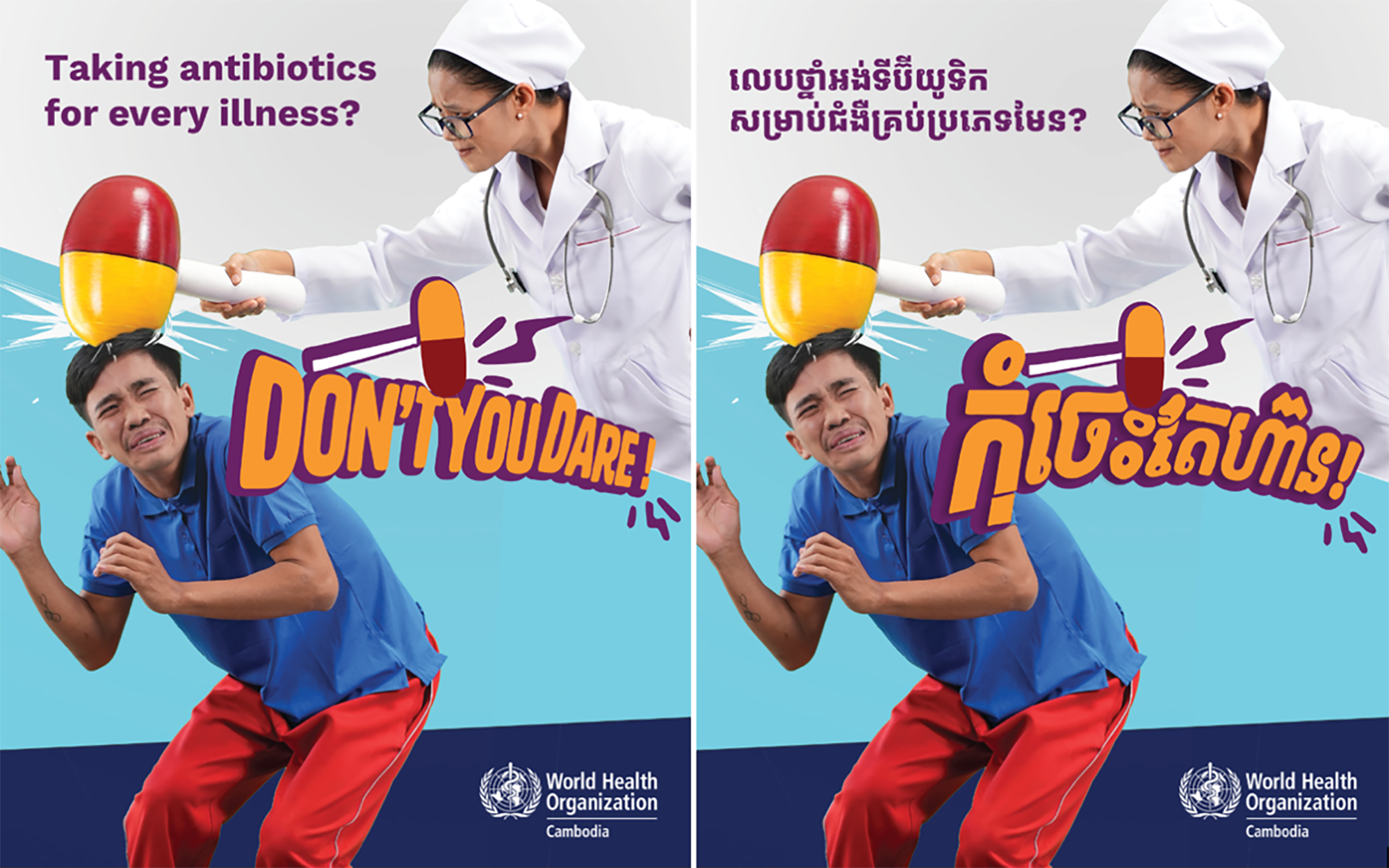Antimicrobial resistance (AMR) poses a significant threat to public health, projected to cause 5.2 million deaths in the WHO Western Pacific Region between 2020 and 2030. Just this month, 26 Asia-Pacific countries endorsed a joint position paper on AMR at the 77th World Health Assembly and committed to work together more effectively to tackle the threat. But, despite its significance, AMR often fails to capture the attention of young adults, who wield influence on social media and often set trends for cultural and social discourse.
Applying the principles and practices of the Communication for Health (C4H) approach, the World Health Organization (WHO) launched a pilot campaign targeted at university students and youth in Cambodia’s capital Phnom Penh. Running for two weeks in December 2023, the campaign, both online and offline, employed humour and behavioural insights and resulted in more than a 30% increase in knowledge around the responsible use of antibiotics.
People-centred approach: co-creating with the audience
The campaign built on the success of an Innovation Hackathon, a ground-breaking initiative in the Region aimed at engaging youth in addressing the challenge of AMR. In collaboration with a behaviour change lab, WHO engaged the winning team of the Hackathon to test and refine their creative campaign ideas. The result was a humorous “Don’t You Dare” campaign, featuring the memorable character Dr Sokapheap, armed with a pill-shaped hammer, ready to educate about the correct use of antibiotics. “Like most health-seeking behaviours, antibiotic use in Cambodia is very different, and nuanced, from other countries around the world. We knew an adapted campaign would not work, and we needed something entirely localised,” explained Lisa Smyth, C4H Technical Officer with WHO Cambodia.
The final campaign concept emerged after an in-depth co-creation session with the winning hackathon team. While humour was central to this concept, alternative approaches using fear-based messaging were also explored. Through in-depth interviews and focus group discussions involving 32 young Cambodians aged 18-25 years old, the “Don’t You Dare” campaign resonated most with the target audience, scoring significantly higher for memorability and shareability. Participants found the concept funny, felt informed and felt confident on what they should be doing, sharing feedback such as “This video is talking about me! I need a punch for how I’ve used antibiotics!”, “A good scolding!” and “She has our best interest at heart!”

The “Don’t You Dare” key visuals were designed after the creative concept had been found to resonate most strongly with a sample of our target audience. They preferred simple messaging and loved the fun, memorable characters.
Credit: © WHO/17 Triggers
Evidence-informed strategy: Gathering insights and testing assumptions
Another key aspect of the campaign development was testing assumptions about antibiotic use among youth. Insights from in-depth interviews and discussions with young professionals revealed widespread misconceptions and incorrect behaviours related to antibiotics use in Cambodia, consistent with results from a public survey1, such as the acceptability of keeping leftover antibiotics for future use, sharing them with family and friends if they have similar symptoms, and not completing a full dose if you feel better. The testing revealed that 88% of youth had taken medication without knowing if it was an antibiotic. They often confused antibiotics with simple medicines, and nearly 3 out of 4 wouldn’t ask questions about their medication from their healthcare professional.
These findings informed the creation of tailored content and key messages aimed at educating the target audience and promoting responsible antibiotic use. A chatbot with an interactive quiz was available on Facebook as part of the campaign, which allowed for the establishment of baseline and endline knowledge scores. At the same time as the digital campaign was rolled out, in-person activations on university campuses using the doctor character encouraged youth to undertake the online quiz and increase their knowledge about antibiotic use.

The on-ground activation team, including the doctor character and her team, approached groups of students and quizzed them on facts about medication and antibiotics. At the end of the interaction, students were given flyers with QR codes that once again directed them to the online campaign.
Credit: © WHO/17 Triggers
Outcome-focused approach: Driving impact
The campaign achieved remarkable online visibility, exceeding its initial goal by reaching 4.15 million impressions across online platforms. High levels of engagement were observed, with the hero video garnering an impressive 21.7% engagement rate. Through a combination of online and in-person activations, the campaign prompted 1,889 chatbot conversations promoting responsible antibiotic use.
The pre- and post-campaign chatbot quiz revealed a 15% jump in the overall knowledge score from 71% to 86%. More significantly, the knowledge of behaviours with the lowest scores before the campaign saw the greatest improvement of over 30% post-campaign. These findings underscore the importance of evidence-based, people-centred and impact-driven communication - the cornerstone of the Communication for Health (C4H) approach. “The campaign highlights that we can't assume antibiotic and AMR knowledge; we need to take a step back and test our assumptions. Research, evaluation and learning is key. Without the input of youth and their co-creation, we would never have landed on such an effective concept,” said Ms Smyth.
___________________________________________
1 Jane Mingjie Lim, Pheak Chhoun, Sovannary Tuot, Chhorvoin Om, Sidonn Krang, Sovann Ly, Li Yang Hsu, Siyan Yi, Clarence C Tam, Public knowledge, attitudes and practices surrounding antibiotic use and resistance in Cambodia, JAC-Antimicrobial Resistance, Volume 3, Issue 1, March 2021, dlaa115, https://doi.org/10.1093/jacamr/dlaa115
